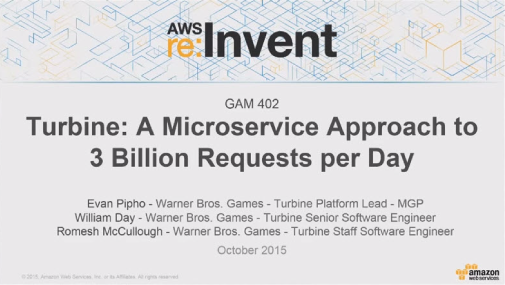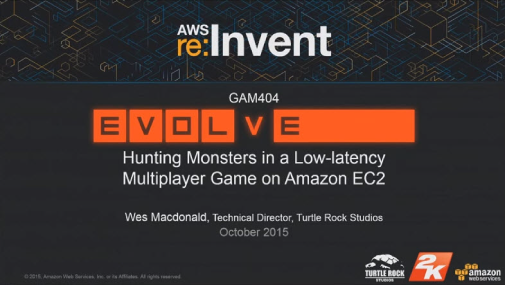At re:Invent 2015, AWS presented a day of sessions designed to help game developers learn more about Amazon Web Services and industry best practices around integrating cloud services to support studio operations and their games. Below is the content from re:Invent 2015; we hope you enjoy them as much as we enjoyed making them for you.
GAM201 - Cloud Gaming Architectures from Mobile to Social to MMO
In this session, AWS shares best practices for launching a game that can scale from 1,000 to 1,000,000 users, while paying only for what you use. We'll show how to create a game backend using Amazon EC2 and AWS Elastic Beanstalk. Learn about database scaling challenges, and how to use Amazon DynamoDB, Amazon RDS, and Amazon ElastiCache to address them. Then, see how to use AWS automation features such as CloudFormation to take your game to new regions worldwide. Finally, hear how to deliver game assets efficiently using Amazon S3 and Amazon CloudFront.
GAM202 - Three New Ways to Monetize featuring Backflip Studios
The average game developer only monetizes 2-3% of their customers. What if you could monetize 100% of them? We’ll talk with Bryan Mashinter from Backflip Studios about three new ways to do this. In this session you’ll learn about: Amazon Underground where customers get premium apps and in-app items for free and developers get paid for all of the minutes used, Merch by Amazon a self-service on-demand t-shirt printing service that costs you nothing out of pocket, and Amazon Coins to help deepen engagement and improve your ARPU (average revenue per user)
GAM303 - Riot Games: Migrating Mountains of Big Data to AWS
Riot Games serves an international base of players that creates terabytes of data daily. With their data centers quickly reaching capacity, Riot Games migrated their entire warehouse to AWS in order to scale operations more effectively. Learn how Riot Games used DynamoDB and Elastic MapReduce to import millions of rows of customer metrics. Hear about the technical specifics involved, and the lessons learned along the way of migrating large amounts of data to AWS.
GAM401 - Build a Serverless Mobile Game with Amazon Cognito, Lambda, and DynamoDB
Get a hands-on walkthrough of how to quickly build a mobile game with online services like user authentication, downloadable content, and social features. Using the AWS Mobile SDK for Unity, iOS, and Android, it's easier than ever to build a game with these services. This session provides a step-by-step approach to add features to your game such as user identity management, dynamic content updates, cross-platform data sync, and more. We demonstrate how to use the AWS Mobile SDK to securely interact with services such as Amazon Cognito, Amazon DynamoDB, Amazon S3, and AWS Lambda.
- Tara Walker - Technical Evangelist, Amazon Web Services, Amazon Web Services
- Dhruv Thukral - Solutions Architect, Gaming, Amazon Web Services
GAM402 - Turbine: A Microservice Approach to Three Billion Game Requests a Day
Turbine shares lessons learned from their new microservice game platform, which used Docker, Amazon EC2, Elastic Load Balancing, and Amazon ElastiCache to scale up as the game exceeded expectations. Learn about their Docker-based microservices architecture and how they integrated it with a legacy multiplatform game-traffic stack. Turbine shares how they gracefully degraded their services rather than going down and how they dealt with unpredictable client behavior. Hear how they resharded their live MongoDB clusters while the game was running. Finally, learn how they broke their game-event traffic into a separate Kafka-based analytics system, which handled the ingestion of over two billion events a day.
GAM403- From Zero to 400 Billion Stars and a Real-time Commodities Market
Elite Dangerous is a Kickstarter-backed, massive-scale space MMO by Frontier Games. With no prior experience with AWS, Frontier have used EC2, S3, RDS, DynamoDB, Elasticache, and CloudFormation to deploy a cross-platform PC & Console MMO experience that is sold and distributed worldwide. Every action made by each of the 825,000 (and counting) Elite Dangerous players drives the combined game's story forward, and impacts a live galactic commodities market running on EC2 and RDS in real-time. Frontier uses AWS to create a simulation of the entire 400 billion star systems of the Milky Way galaxy using physics engines running on Amazon EC2. Finally, learn how Elite distributes updates and DLC to game clients using Amazon S3 and Amazon CloudFront.
- David Walsh - C.O.O., Frontier Developments plc
- Dav Stott - Senior Server Developer, Frontier Developments PLC
GAM404 - Evolve: Hunting Monsters in a Low-Latency Multiplayer Game on EC2
Hear how Turtle Rock launched Evolve, their fast-paced mercenary-vs-monster first-person shooter (FPS), to millions of players using AWS regions around the globe. Turtle Rock provides an in-depth view into Evolve's architecture on AWS, including both their Amazon EC2 and Elastic Load Balancing web API stack, as well as their Crytek-based UDP game servers. Hear how they used Amazon VPC subnets, along with an RDS MySQL based server registration service, to balance players across Availability Zones and regions. Learn about Turtle Rock's innovative game server scaling logic, which maintains a pool of game server capacity while keeping costs in check. Finally, see Evolve’s Graphite and Grafa monitoring setup, which provides player count and server health status across their worldwide fleet.
GAM405 - HTML5 vs Unity for Responsive Game Design
Game developers have lots of options when it comes to picking platforms and frameworks for building their games. If you are looking to build true cross-platform games, there are two great options: HTML5 and Unity. But knowing which one to start with can be difficult. This talk discusses the pros and cons of each platform by looking at the same game built in Phaser (http://phaser.io) and Unity. We also discuss publishing options for both platforms and how to create truly cross-platform games from a single codebase.
GAM406 - Glu Mobile: An Amazon Kinesis Platform to Process Real-time Analytics for 10 MM + Devices
Glu uses Amazon Kinesis, Apache Storm, S3, and Hadoop to collect billions of data points from millions of user devices in real-time every single day. This session describes how Glu built and configured an array of producers to submit real-time gaming events into Amazon Kinesis, using temporary tokens from Amazon Cognito, removing the need for an intermediate store-forward fleet. We then discuss how we've been able to easily integrate Amazon Kinesis with powerful open-source technologies such as Apache Storm and the Hadoop ecosystem. Finally, we discuss KCL optimizations and tradeoffs to manage a scalable, flexible, mission-critical streaming data platform.
GAM407 - Quiplash: The Multiscreen, Multidevice, Multiplayer Game for 10,000
Jackbox Games, the makers of Fibbage and You Don’t Know Jack, want everyone to be able to join the fun. They design games that thousands of people can play together at the same time from their phone, tablet, computer, or set-top box. Quiplash is their newest release, and it is THE game to play at parties, family events, and public gatherings. It combines local multiplayer with massively multiplayer so the whole room can play with the whole world. Multidevice means anyone can play, and multi-screen creates an experience that is fun for both participants and spectators.
Attend this session to hear how Jackbox Games achieved this. They describe the system architecture and technology they employed to bring Quiplash to life and explain the importance of AWS, Fire TV, and Twitch to their development process. They also discuss the design decisions that made it possible to support multiple screens and multiple devices for thousands of concurrent players.









